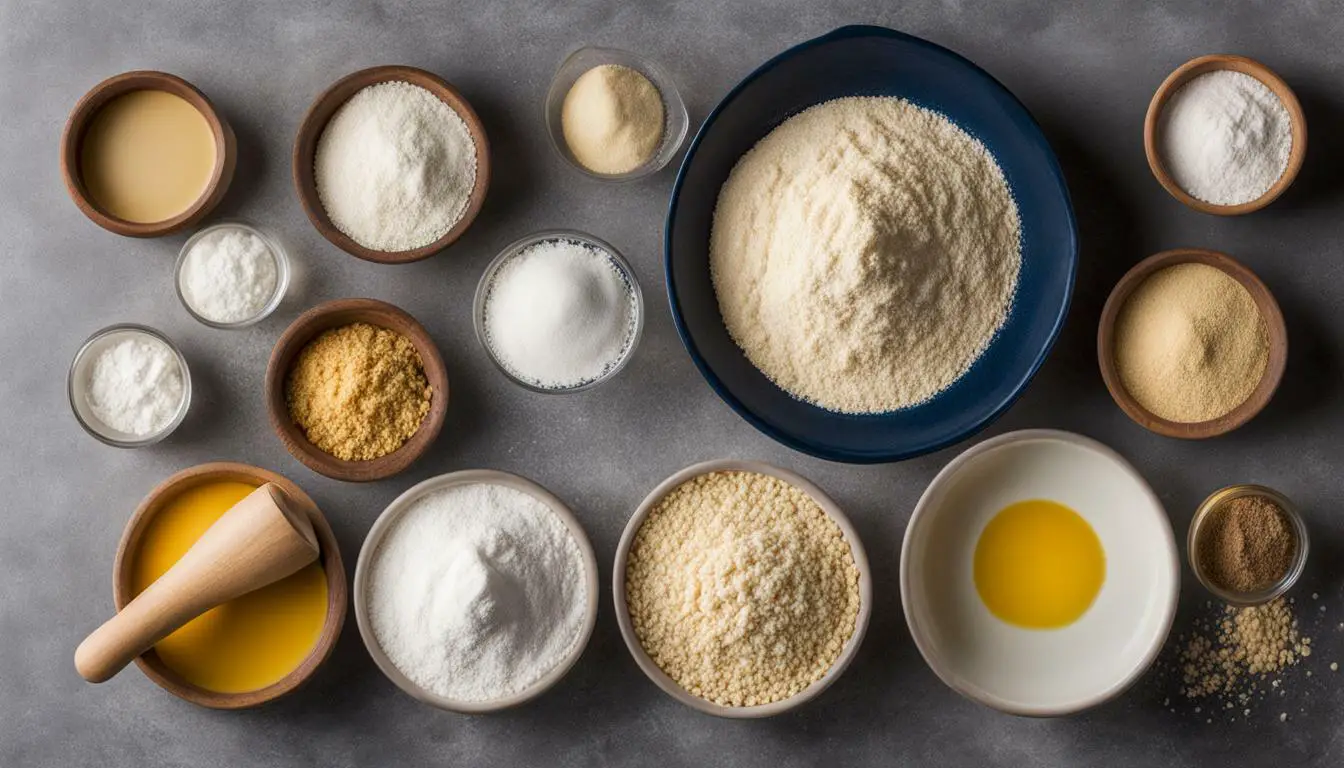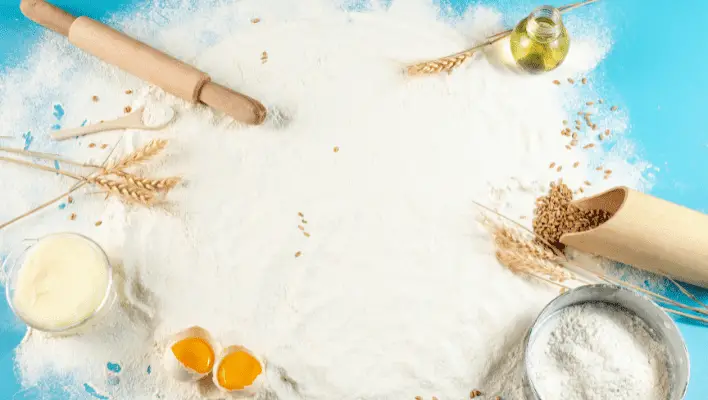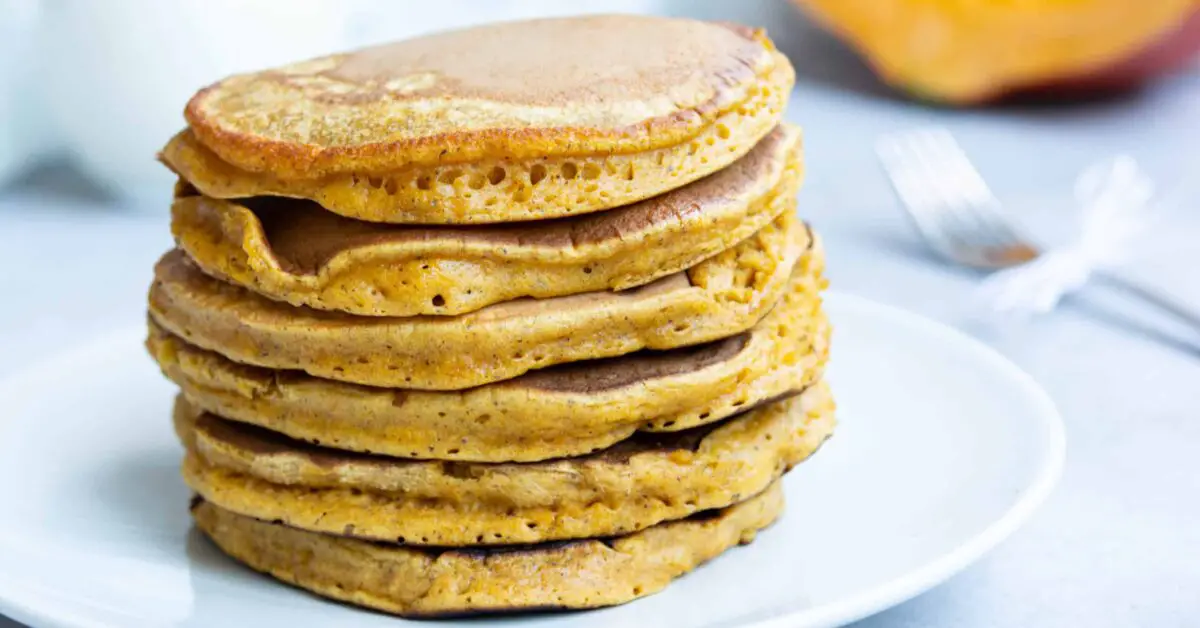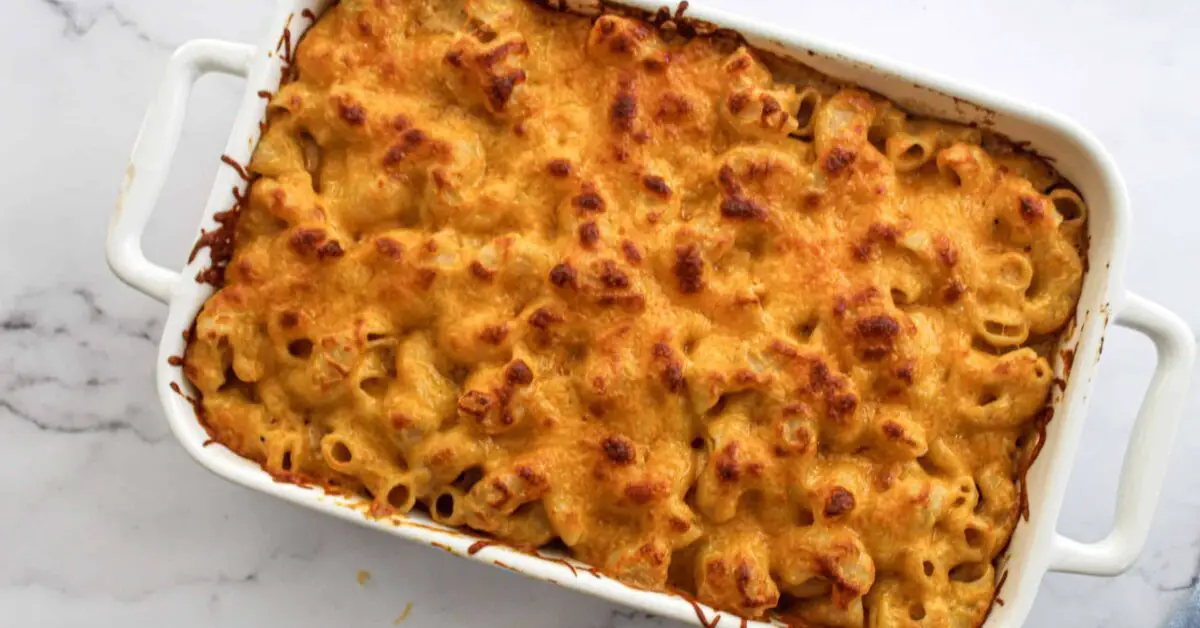
This post may contain affiliate links. Please read my disclosure for more information.
Looking for alternatives to cornstarch in your baking recipes? Discover nine fantastic substitutes that can enhance texture and taste.
Key Takeaways:
- All-purpose flour can be used as a substitute for cornstarch in a 2:1 ratio.
- Arrowroot powder is a one-to-one replacement for cornstarch.
- Potato starch can be used in the same amount as cornstarch.
- Rice flour is a suitable substitute for cornstarch in a 2:1 ratio.
- Tapioca starch works well in a 2:1 ratio as a substitute for cornstarch.
All-Purpose Flour: A Versatile Substitute for Cornstarch in Baking
All-purpose flour can be a versatile substitute for cornstarch in baking, with a simple ratio of two tablespoons of flour for every tablespoon of cornstarch. This common pantry staple is readily available and can help achieve the desired texture in various recipes.
When substituting all-purpose flour for cornstarch, it’s important to keep in mind that the flour may not provide the exact same thickening power as cornstarch. However, it can still help bind ingredients together and give baked goods a soft and tender texture.
To use all-purpose flour as a substitute, simply measure out two tablespoons of flour for every tablespoon of cornstarch called for in the recipe. Mix the flour with other dry ingredients before incorporating them into the batter or dough. Keep in mind that using all-purpose flour may result in a slightly denser final product, but it can still yield delicious results.
| Cornstarch | All-Purpose Flour |
|---|---|
| 1 tablespoon | 2 tablespoons |
Remember that experimentation is key when substituting ingredients in baking. Feel free to adjust the amount of all-purpose flour used based on the desired thickness and consistency of the final product. The versatility of all-purpose flour makes it a reliable choice for those looking to bake without cornstarch.
Arrowroot: A Gluten-Free Substitute for Cornstarch in Baking
For a gluten-free option, consider using arrowroot powder as a substitute for cornstarch in your baking recipes, with a one-to-one ratio. Arrowroot is a versatile ingredient that can enhance the texture and thickness of your baked goods, without compromising on taste.
With its fine texture and neutral flavor, arrowroot is an excellent choice for those with dietary restrictions or preferences. It works well in a variety of recipes, including cakes, cookies, and sauces.
When using arrowroot as a cornstarch substitute, simply replace one tablespoon of cornstarch with one tablespoon of arrowroot powder. This one-to-one ratio ensures that your recipe maintains its desired thickness. Arrowroot has a lower risk of causing lumps compared to cornstarch, making it easier to incorporate into your batter or sauce.
Table: Arrowroot Substitute Ratio
| Cornstarch | Arrowroot Powder |
|---|---|
| 1 tablespoon | 1 tablespoon |
Whether you are following a gluten-free diet or simply prefer to explore alternative ingredients, arrowroot is a reliable substitute for cornstarch in baking. Incorporate it into your recipes and enjoy the same desired texture and thickness in your baked treats.
Potato Starch: A Versatile Substitute for Cornstarch in Baking
For a slightly different texture in your baked goods, consider using potato starch as a substitute for cornstarch, with a one-to-one ratio. Potato starch is a gluten-free option that adds moisture and helps create a tender crumb.
When using potato starch as a substitute for cornstarch, it’s important to note that it may result in a slightly denser finished product. However, it can still provide excellent results and is particularly well-suited for recipes like cakes, cookies, and muffins.
How to Use Potato Starch as a Substitute for Cornstarch
To substitute cornstarch with potato starch, simply replace each tablespoon of cornstarch with one tablespoon of potato starch. It’s a straightforward one-to-one ratio that makes it easy to adapt your recipes without sacrificing taste or texture.
Here’s a handy chart summarizing the best ways to substitute cornstarch in baking:
| Cornstarch | Substitute |
|---|---|
| 1 tablespoon | 1 tablespoon of potato starch |
By using potato starch as a substitute for cornstarch, you can explore new flavors and textures in your baking while still achieving the desired thickness. Whether you’re looking for gluten-free options or simply want to try something different, potato starch can be a great alternative to enhance your culinary creations.
Rice Flour: A Versatile Substitute for Cornstarch in Baking
Rice flour can be a suitable substitute for cornstarch in baking, offering a gluten-free option with a similar thickening effect. With a ratio of two tablespoons of rice flour for every one tablespoon of cornstarch, it can be easily incorporated into various recipes.
One of the advantages of using rice flour as a substitute is its versatility. It can enhance the texture and taste of baked goods, making them light and crispy. Rice flour is particularly useful in recipes that require a delicate balance of moisture and crispness, such as cookies, cakes, and bread.
When using rice flour as a substitute for cornstarch, it is important to consider the ratio to maintain the desired consistency. The slightly higher ratio ensures adequate thickening without altering the overall texture of the baked goods. However, it is essential to experiment and adjust the ratio according to personal preference and the specific recipe being used.
Table: Rice Flour Substitute Ratio
| Ingredient | Ratio |
|---|---|
| Rice Flour | 2 tablespoons |
| Cornstarch | 1 tablespoon |
By substituting cornstarch with rice flour, individuals with gluten sensitivities or dietary restrictions can still enjoy their favorite baked goods. Remember to adjust baking times and temperatures as needed, as rice flour can impact the overall texture and browning of the final product.
Tapioca Starch: A Chewy and Versatile Substitute for Cornstarch
If you’re looking for a substitute that can add a chewy texture to your baked goods, consider using tapioca starch as a replacement for cornstarch, with a ratio of two tablespoons of tapioca starch for one tablespoon of cornstarch. Tapioca starch, derived from the cassava root, is a gluten-free and grain-free ingredient that can enhance the texture and thickness of your baked treats.
One of the key advantages of tapioca starch as a substitute for cornstarch is its ability to create a chewy and elastic texture in baked goods. When used in recipes like cookies, cakes, and pastries, tapioca starch can provide a delightful gooeyness that cornstarch may lack. It works particularly well in gluten-free recipes, where achieving the desired texture can be more challenging.
To use tapioca starch as a substitute, simply replace one tablespoon of cornstarch with two tablespoons of tapioca starch. This ratio ensures that your baked goods maintain their structure while adding a chewy bite. Keep in mind that tapioca starch may have a slightly different taste compared to cornstarch, so it’s important to consider the overall flavor profile of your recipe.
Whether you’re baking for dietary restrictions or simply looking to experiment with new textures, tapioca starch can be a valuable substitute for cornstarch in your recipes. Its chewy and elastic properties make it an excellent choice for creating delightful treats that both gluten-free and non-gluten-free eaters will enjoy.
Note:
Remember to always test and adjust the amount of tapioca starch in your recipes based on your desired texture and thickness. It’s best to start with the recommended ratio and make gradual adjustments as needed. Additionally, tapioca starch can be used as a thickener in other cooking applications, such as soups and sauces, offering versatility beyond baking.
| Substitute | Ratio |
|---|---|
| All-Purpose Flour | 2 tablespoons per 1 tablespoon of cornstarch |
| Arrowroot | 1 tablespoon per 1 tablespoon of cornstarch |
| Potato Starch | 1 tablespoon per 1 tablespoon of cornstarch |
| Rice Flour | 2 tablespoons per 1 tablespoon of cornstarch |
| Tapioca Starch | 2 tablespoons per 1 tablespoon of cornstarch |
| Almond Flour | Equal amount as cornstarch |
| Cassava Flour | Twice the amount of cornstarch |
| Ground Flaxseeds | 2 tablespoons with 1/2 tablespoon of water per 1 tablespoon of cornstarch |
| Xanthan Gum | Start with a small amount and adjust as needed |
Conclusion
With these nine substitutes for cornstarch in baking, you can enhance the texture and taste of your recipes without compromising on quality. Try out different options and ratios to find the perfect substitute for your baking needs.
All-purpose flour is a versatile substitute, with a ratio of 2 tablespoons of flour for every tablespoon of cornstarch. Arrowroot powder can be used in a 1:1 ratio, offering a smooth texture. Potato starch, rice flour, and tapioca starch are other alternatives, each with its own recommended ratio for replacing cornstarch.
If you’re looking for gluten-free options, almond flour and cassava flour can be used as substitutes. Ground flaxseeds mixed with water can also provide a thickening effect, replacing one tablespoon of cornstarch. Finally, xanthan gum is a helpful option that can be added gradually until the desired thickness is achieved.
Experimenting with these substitutes will enable you to customize your recipes and cater to dietary preferences or restrictions. Whether baking cookies, cakes, or pies, you can achieve excellent results without using cornstarch. Enjoy exploring these alternatives and elevating your baking creations to new heights!
FAQ
Can I replace cornstarch with all-purpose flour in baking?
Yes, you can substitute 2 tablespoons of all-purpose flour for every tablespoon of cornstarch.
What is the equivalent amount of arrowroot powder to cornstarch?
Use one tablespoon of arrowroot powder for one tablespoon of cornstarch.
Can potato starch be used as a substitute for cornstarch in baking?
Yes, you can substitute one tablespoon of potato starch for one tablespoon of cornstarch.
How much rice flour should I use as a substitute for cornstarch?
Use two tablespoons of rice flour for every one tablespoon of cornstarch.
Can tapioca starch be used in place of cornstarch?
Yes, you can substitute two tablespoons of tapioca starch for one tablespoon of cornstarch.
Is almond flour a suitable substitute for cornstarch?
Yes, you can use an equal amount of almond flour as a substitute for cornstarch.
Can cassava flour replace cornstarch in recipes?
Yes, you can replace cornstarch with twice the amount of cassava flour.
How can I substitute ground flaxseeds for cornstarch?
Mix 2 tablespoons of ground flaxseeds with 1/2 tablespoon of water to replace one tablespoon of cornstarch.
Can xanthan gum be used as a thickening agent instead of cornstarch?
Yes, start with a small amount of xanthan gum and slowly add more as needed for thickening.


